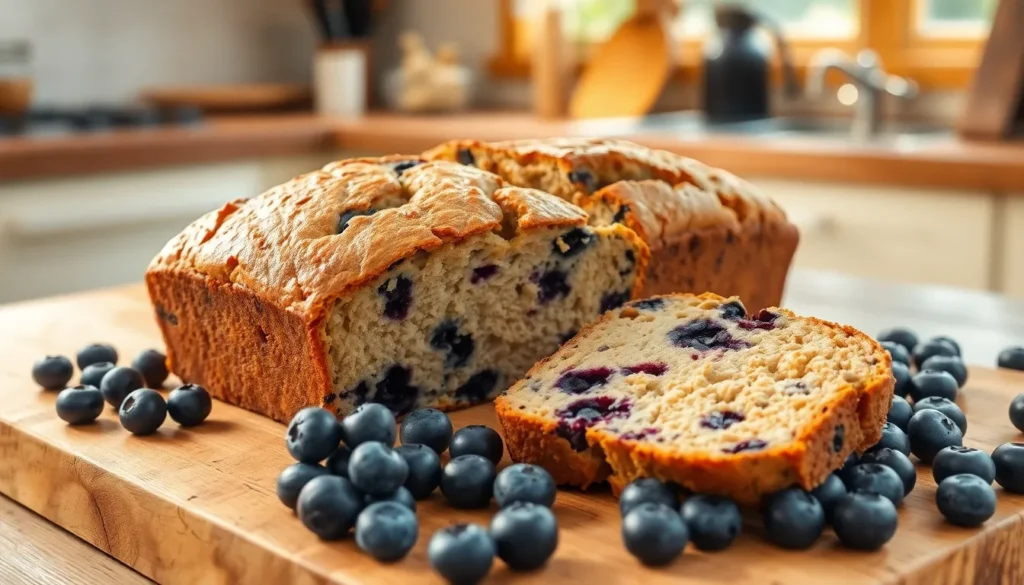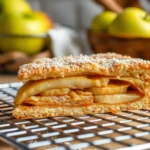We’ve all experienced that moment when fresh blueberries are calling our name from the kitchen counter, begging to be transformed into something extraordinary. Blueberry bread delivers that perfect balance of tender crumb and bursting fruit flavor that makes breakfast feel like a celebration.
This isn’t your average quick bread – it’s a moist, flavorful loaf that captures summer’s essence in every bite. Whether you’re using fresh berries from the farmer’s market or frozen ones from your freezer stash, this recipe creates bakery-quality results right in your own kitchen.
What makes our blueberry bread special is the technique that prevents those berries from sinking to the bottom while ensuring they’re distributed throughout every slice. You’ll love how the natural sweetness of blueberries pairs with hints of vanilla and lemon, creating a bread that’s perfect for breakfast, afternoon tea, or even dessert.
Ingredients
We’ve carefully selected each ingredient to create the perfect balance of flavors and textures in our blueberry bread. These components work together to deliver that tender crumb and burst of fruity goodness we mentioned earlier.
Dry Ingredients
- 2 cups all-purpose flour
- 3/4 cup granulated sugar
- 2 teaspoons baking powder
- 1/2 teaspoon salt
- 1/4 teaspoon ground cinnamon
Wet Ingredients
- 1/3 cup unsalted butter, melted and cooled slightly
- 1 large egg, room temperature
- 1 cup whole milk
- 1 teaspoon vanilla extract
- 1 tablespoon fresh lemon juice
- 1 teaspoon lemon zest
Blueberries
- 1 1/2 cups fresh or frozen blueberries
- 1 tablespoon all-purpose flour (for coating berries)
Equipment Needed
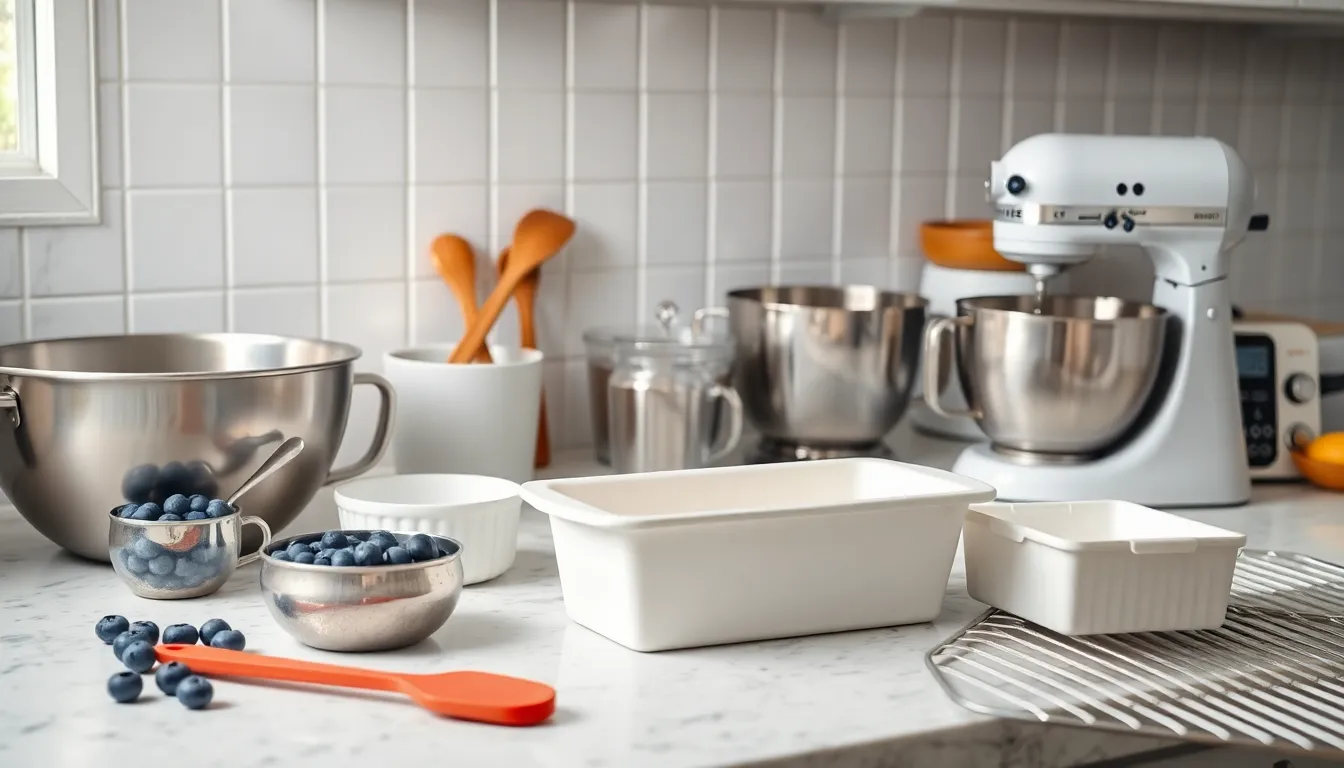
Creating the perfect blueberry bread requires having the right tools on hand to ensure our baking success. We’ve compiled a comprehensive list of essential equipment that will help you achieve bakery-quality results at home.
Large Mixing Bowl serves as our primary workspace for combining ingredients. We recommend using a bowl with a 3.5 to 4.5 quart capacity to provide ample room for whisking and incorporating air into our batter without spillage.
Measuring Cups and Spoons ensure accuracy in our recipe execution. Precise measurements make the difference between dense bread and perfectly tender loaves. We suggest using separate measuring cups for dry and wet ingredients to maintain consistency.
Electric Mixer streamlines the mixing process significantly. Whether you choose a hand mixer or stand mixer, this tool helps us cream butter and sugar effectively while incorporating eggs and wet ingredients with ease.
9×5-inch Loaf Pan creates the classic blueberry bread shape we’re aiming for. This standard size ensures even baking and produces slices that are perfect for serving.
Rubber Spatula becomes indispensable when folding delicate blueberries into our batter. This tool helps us scrape bowl sides thoroughly while preventing berry bursting during the mixing process.
Oven Thermometer guarantees accurate baking temperatures. Since oven calibration varies, this tool ensures our bread bakes evenly throughout.
Digital Scale offers superior measurement precision when available. Professional bakers rely on weight measurements for consistent results batch after batch.
Cooling Rack or Baking Sheet provides proper air circulation around our finished loaf. This equipment prevents soggy bottoms while allowing steam to escape during the cooling process.
Before beginning, we always preheat our oven to the specified temperature and grease our loaf pan with butter or non-stick spray to prevent sticking issues.
Instructions
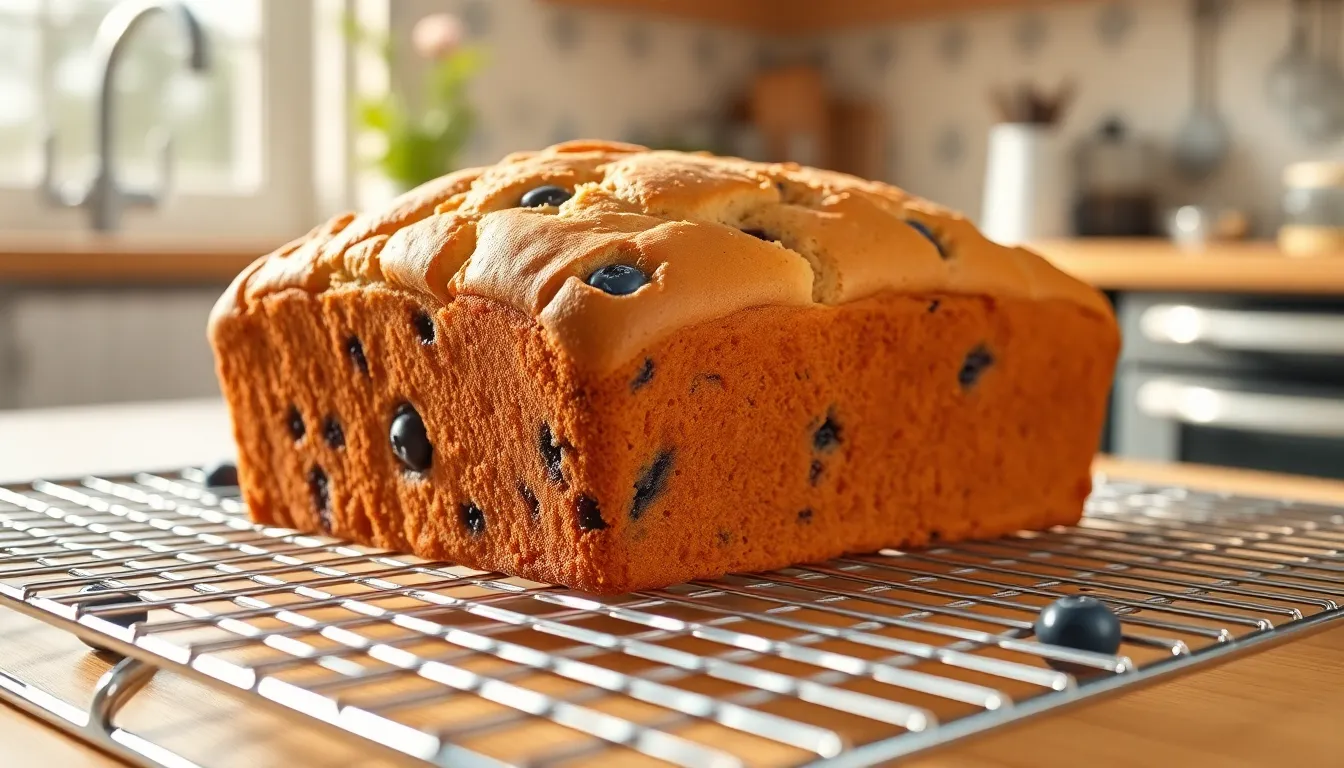
Follow these detailed steps to create perfect blueberry bread with evenly distributed berries and a tender crumb. We’ll guide you through each stage to ensure bakery-quality results.
Prep the Pan and Oven
Preheat your oven to 350°F (175°C) to ensure even baking throughout the loaf. Grease your 9×5-inch loaf pan thoroughly with butter or coat with baking spray to prevent sticking. Line the bottom with parchment paper for extra insurance when removing the finished bread.
Mix the Dry Ingredients
Whisk together 2 cups all-purpose flour, 3/4 cup granulated sugar, 2 teaspoons baking powder, 1/2 teaspoon salt, and 1/2 teaspoon ground cinnamon in a large mixing bowl. Make sure all dry ingredients are evenly distributed with no lumps remaining. Set this mixture aside while we prepare the wet ingredients.
Combine Wet Ingredients
Melt 1/3 cup butter and allow it to cool slightly before proceeding. Beat 1 large egg in a separate bowl until smooth. Add 3/4 cup milk, the cooled melted butter, 1 teaspoon vanilla extract, 1 tablespoon fresh lemon juice, and 1 teaspoon lemon zest to the beaten egg. Stir these wet ingredients until they’re completely combined and uniform in texture.
Prepare the Blueberries
Place 1 1/2 cups fresh or frozen blueberries in a medium bowl. Sprinkle 2 tablespoons of flour from your measured dry ingredients over the berries. Gently toss the blueberries with the flour until each berry is lightly coated. This coating prevents the berries from sinking to the bottom during baking.
Combine Wet and Dry Ingredients
Pour the wet ingredient mixture into the bowl containing the dry ingredients. Stir gently with a rubber spatula just until the ingredients begin to come together. Leave a few streaks of dry flour visible rather than overmixing, which can result in tough bread.
Fold in Blueberries
Add the flour-coated blueberries to the batter using a gentle folding motion. Turn the spatula under the batter and fold over the top to incorporate the berries without bursting them. Continue this folding technique until the blueberries are evenly distributed throughout the batter.
Bake the Bread
Transfer the batter to your prepared loaf pan and spread it evenly with the spatula. Bake for 55-65 minutes until the top is golden brown and a toothpick inserted into the center comes out with just a few moist crumbs attached. Begin checking for doneness at the 50-minute mark to prevent overbaking. Allow the bread to cool in the pan for 10 minutes before transferring to a wire rack to cool completely.
Baking Tips for Perfect Blueberry Bread
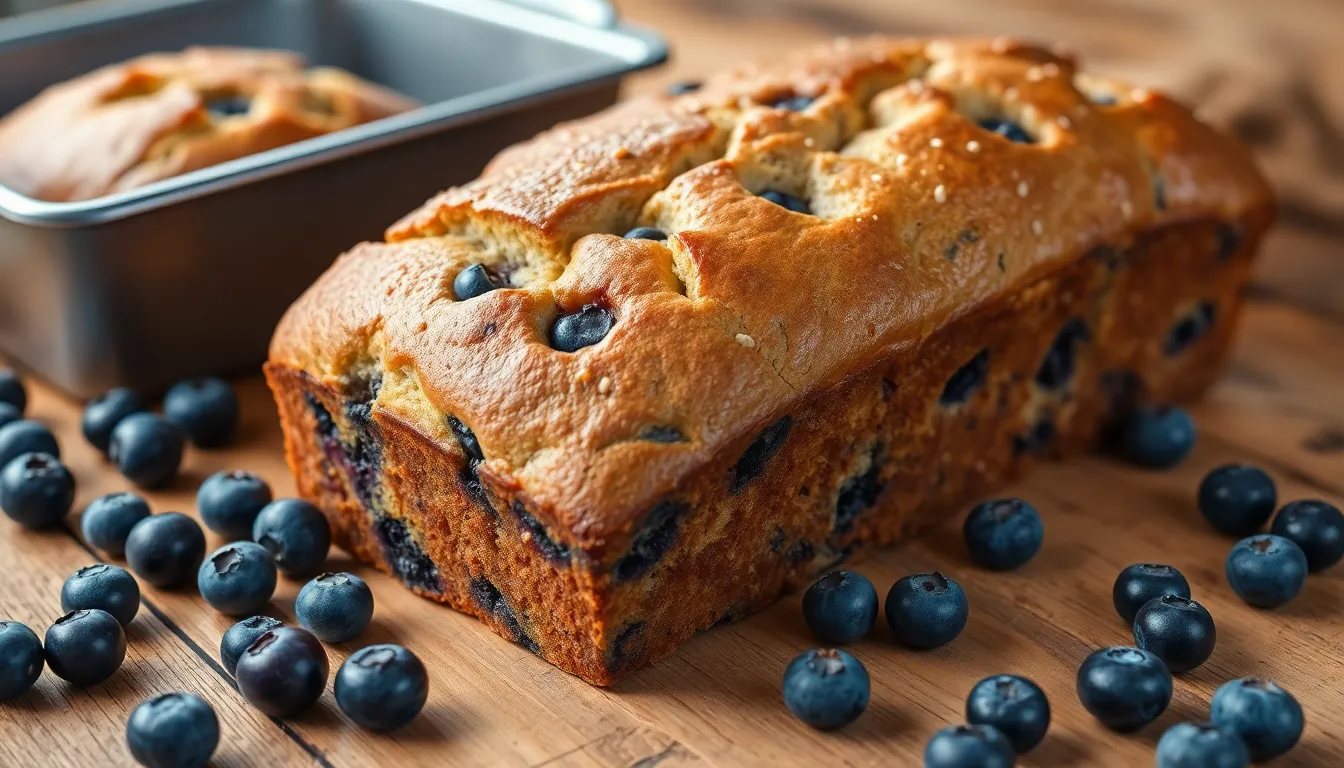
We’ve discovered that achieving bakery-quality blueberry bread requires attention to several crucial details that make the difference between good and exceptional results.
Avoid Overmixing the Batter
Gentle handling transforms our blueberry bread from dense to tender. We recommend mixing wet and dry ingredients separately before combining them until just incorporated. Overworking the dough creates tough and dense bread that lacks the light texture we desire. The batter should look slightly lumpy rather than perfectly smooth when we finish mixing.
Prevent Blueberries from Sinking
Our secret technique involves coating blueberries with a small amount of flour before folding them into the batter. This simple step prevents the berries from settling to the bottom during baking and ensures even distribution throughout each slice. We toss the berries in about 1 tablespoon of flour until they’re lightly dusted.
Master the Oven Temperature and Timing
Consistent results depend on maintaining our oven at 350°F throughout the baking process. We typically bake for 45 to 60 minutes depending on our pan size and exact ingredients used. Testing with a toothpick inserted into the center confirms doneness when it comes out clean or with just a few moist crumbs.
Control Browning for Even Results
Monitoring our loaf prevents over-browning that can create bitter flavors. We cover the bread loosely with aluminum foil after 40 minutes of baking if the top appears to be browning too quickly. This technique allows the interior to finish cooking while protecting the surface.
Choose the Right Baking Pan
Using a 9×5-inch loaf pan delivers optimal results for our blueberry bread recipe. Different pan sizes affect baking time and texture so we adjust our timing accordingly when using alternative sizes. Properly greased pans ensure easy removal and prevent sticking.
| Baking Parameter | Recommendation |
|---|---|
| Oven Temperature | 350°F (175°C) |
| Baking Time | 45-60 minutes |
| Pan Size | 9×5-inch loaf pan |
| Foil Cover Time | After 40 minutes if browning |
How to Tell When Your Blueberry Bread Is Done
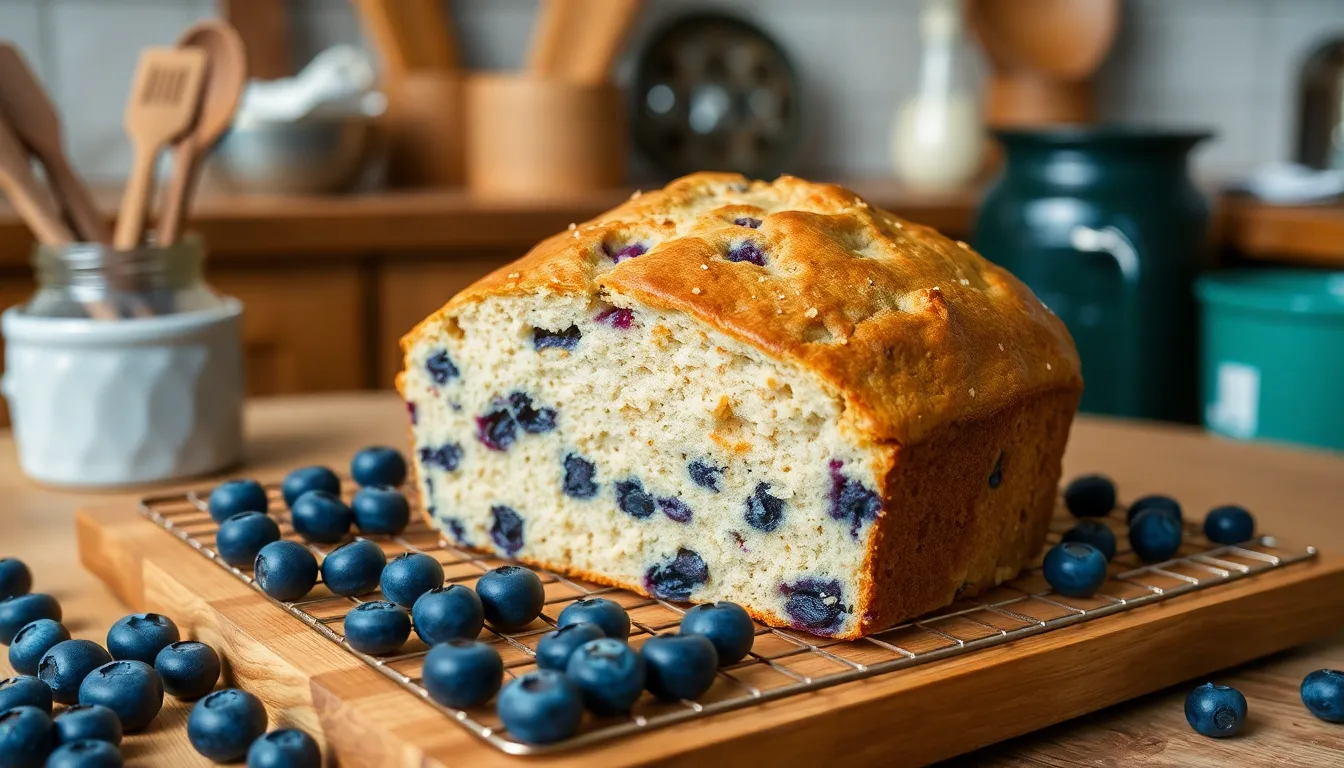
Knowing exactly when our blueberry bread reaches perfect doneness prevents both underbaking and overbaking disasters. We rely on multiple testing methods to ensure consistent results every time we bake this delicious treat.
The Toothpick Test Method
The most reliable technique involves inserting a clean toothpick or cake tester into the center of our loaf near the end of the suggested baking time. When the tester emerges clean or with just a few moist crumbs clinging to it, our bread has finished baking. Wet batter on the toothpick indicates we need additional baking time. If our tester hits a blueberry, we simply clean it off and test another spot in the center area.
Visual Doneness Indicators
Our blueberry bread displays clear visual cues when properly baked. The crust develops a beautiful golden brown color that signals completion. We also check that the center appears set rather than jiggly when we gently shake the pan. These visual markers work alongside our toothpick test for confirmation.
Internal Temperature Guidelines
Using a digital thermometer provides precise doneness measurement for those who prefer exact temperatures. Our blueberry bread reaches completion at an internal temperature between 190°F and 200°F (88°C to 93°C). We insert the thermometer probe into the thickest part of the loaf while avoiding contact with blueberries that might give false readings.
Timing and Cooling Considerations
Standard baking time ranges from 60 to 70 minutes at 350°F (175°C), though individual ovens and pan sizes may require adjustments. Once our bread passes all doneness tests, we allow it to cool in the pan for exactly 10 minutes before transferring to a wire rack. Cutting into warm bread creates a gummy texture, so we wait until completely cooled for the best slicing results.
| Doneness Method | Target Result | Temperature Range |
|---|---|---|
| Toothpick Test | Clean or few moist crumbs | N/A |
| Visual Check | Golden crust, set center | N/A |
| Internal Temperature | Fully cooked | 190°F – 200°F (88°C – 93°C) |
| Baking Time | Standard duration | 60 – 70 minutes at 350°F |
Cooling and Storage
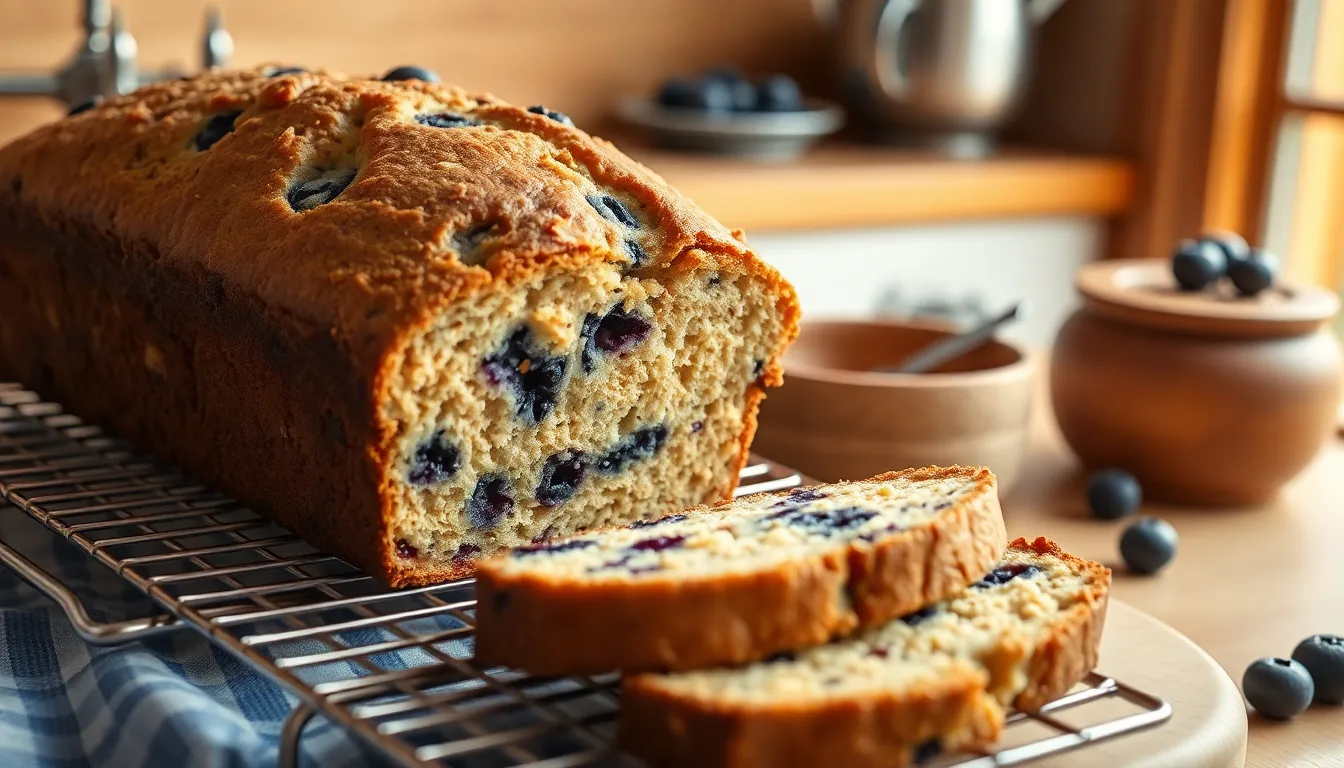
Proper cooling and storage practices ensure our blueberry bread maintains its delicious texture and flavor for days to come. We want to preserve all that hard work and enjoy every slice at its best.
Cooling Instructions
We must allow our blueberry bread to cool completely after removing it from the oven. The loaf should sit in the pan for 10 minutes before we transfer it to a wire rack to finish cooling. This prevents moisture buildup that can make the bottom soggy and helps maintain the bread’s tender texture. Complete cooling also makes the bread much easier to slice cleanly without crumbling. We recommend waiting at least 2 hours before cutting into our freshly baked loaf for the best results.
Storage Tips
Room temperature storage works perfectly for short-term enjoyment. We can keep our blueberry bread fresh for up to 5 days by wrapping it tightly in plastic wrap or storing it in an airtight container placed on a paper towel. The paper towel absorbs any excess moisture while keeping the bread from drying out.
For extended freshness we recommend refrigerator storage in an airtight container for up to 7 days. This method works especially well during warmer months when room temperature storage might cause the bread to spoil more quickly.
Freezing offers the longest storage option for our blueberry bread. We wrap the completely cooled loaf or individual slices tightly in plastic wrap or aluminum foil before placing them in a freezer-safe bag.
| Storage Method | Duration | Container |
|---|---|---|
| Room Temperature | Up to 5 days | Plastic wrap or airtight container with paper towel |
| Refrigerator | Up to 7 days | Airtight container |
| Freezer | 2 to 3 months | Plastic wrap/foil + freezer bag |
Frozen blueberry bread typically maintains quality for 2 to 3 months but remains safe to eat beyond that timeframe. When we’re ready to enjoy frozen bread we remove it from the freezer and allow it to reach room temperature before unwrapping. We always label our frozen loaves with the storage date to track how long they’ve been stored.
Serving Suggestions

Our freshly baked blueberry bread transforms into the perfect centerpiece for any breakfast or brunch spread. We recommend serving warm slices alongside creamy butter and homemade blueberry jam for a delightful morning treat. The combination of sweet bread with tangy jam creates a flavor profile that pairs beautifully with your favorite coffee or tea.
Breakfast and Brunch Options
Transform your morning routine by incorporating blueberry bread into various breakfast presentations. We love toasting thick slices until golden and drizzling them with a light vanilla glaze for extra sweetness. Fresh berries scattered on the plate add visual appeal and complement the blueberries already baked into the bread.
Quick Snack Answers
The portable nature of our blueberry bread makes it an ideal grab-and-go snack option. Wrap individual slices in parchment paper for lunch boxes or afternoon treats. We find that the moist texture and sweet flavor satisfy cravings without requiring additional accompaniments.
Party and Gathering Presentations
Elevate your entertaining game by featuring blueberry bread at parties and social gatherings. Slice the loaf into elegant portions and arrange them on a decorative platter alongside seasonal fruits. We suggest pairing these servings with refreshing beverages like iced tea or sparkling water with lemon for a sophisticated touch.
Thoughtful Gift Ideas
Our blueberry bread recipe creates wonderful homemade gifts for friends and family members. Wrap whole loaves in decorative paper or place them in gift baskets with other baked goods. We recommend including serving suggestions and storage instructions on a handwritten card to make the gift even more special.
Creative Serving Variations
French toast made from day-old blueberry bread creates an exceptional breakfast experience. We soak thick slices in custard mixture and cook them until golden for a restaurant-quality meal at home. Bread pudding represents another excellent way to repurpose leftover slices into an impressive dessert.
Recipe Variations
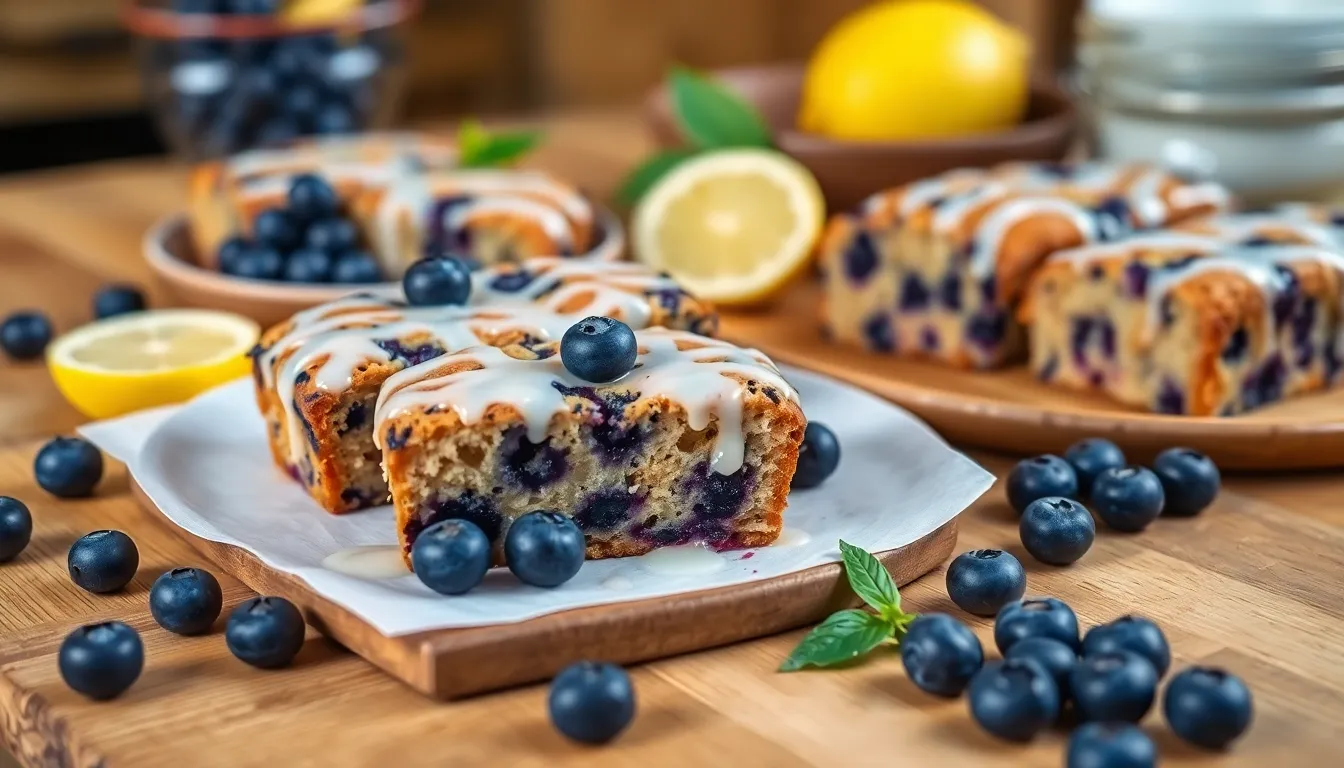
We love how versatile blueberry bread can be with just a few simple adjustments to our base recipe. These variations allow us to customize flavors and accommodate different dietary preferences while maintaining that perfect tender crumb we cherish.
Lemon Blueberry Bread
This bright variation transforms our classic recipe by incorporating fresh lemon juice and zest into the wet ingredients. We add 2 tablespoons of freshly squeezed lemon juice and 1 tablespoon of lemon zest to enhance the flavor profile with vibrant citrus notes that perfectly complement the sweet blueberries.
The magic happens when we top our finished loaf with a simple lemon glaze made from powdered sugar and lemon juice. We whisk together 1 cup of powdered sugar with 2-3 tablespoons of fresh lemon juice until smooth. Once our bread has cooled completely we drizzle this tangy glaze over the top for added sweetness and visual appeal.
The combination creates a bakery-quality treat that balances the tartness of blueberries with zesty citrus brightness. We follow our standard baking instructions maintaining the 350°F temperature and 60-70 minute baking time.
Whole Wheat Blueberry Bread
For a healthier alternative we substitute our all-purpose flour with whole wheat flour to boost fiber content and nutritional value. This variation requires slight adjustments since whole wheat flour absorbs more liquid than regular flour.
We recommend increasing our milk by 2-3 tablespoons to maintain proper batter consistency. The higher fiber content of whole wheat flour can make the batter appear thicker initially. We monitor the dough consistency carefully and add liquid gradually until we achieve the right texture.
The finished bread develops a heartier flavor with a slightly denser crumb that still remains moist and tender. Baking time stays consistent at 60-70 minutes though we check for doneness using our reliable toothpick test since whole wheat varieties can brown more quickly.
Mini Blueberry Loaves
We transform our standard recipe into charming individual portions by dividing the batter between greased mini loaf pans. This variation uses identical ingredients but creates perfect single-serving sizes ideal for gifting or portion control.
The key adjustment involves reducing our baking time by 10-15 minutes compared to our standard loaf. Mini loaves typically bake in 45-50 minutes at 350°F. We check for doneness starting at 45 minutes using the toothpick test since smaller pans conduct heat more efficiently.
These petite loaves make excellent gifts when wrapped in decorative paper or cellophane bags. We can prepare multiple mini loaves from one batch making them perfect for sharing with neighbors, coworkers, or bringing to gatherings where individual portions are preferred.
Troubleshooting Common Issues
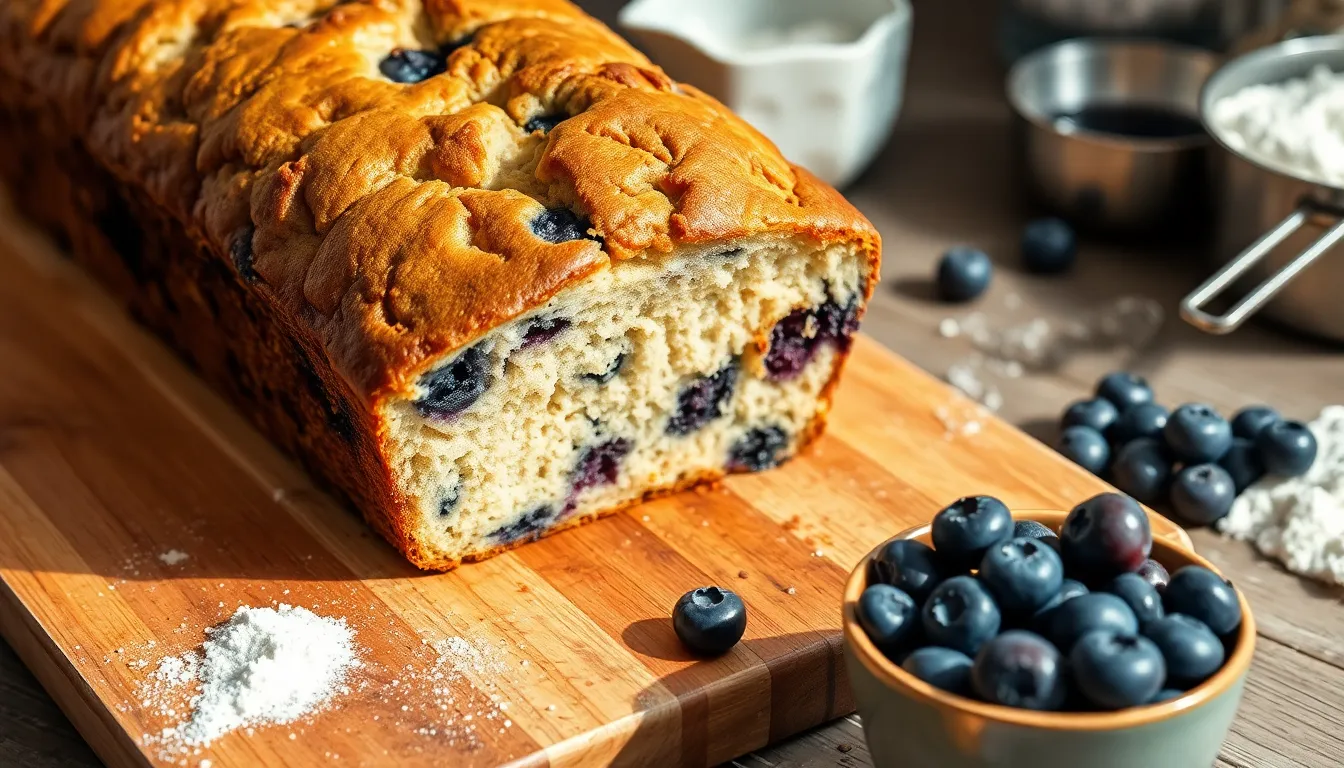
Even experienced bakers encounter challenges when making blueberry bread. We’ve compiled the most common problems and their answers to help you achieve perfect results every time.
Crumbly Texture or Bread Falls Apart
Our blueberry bread should hold together beautifully when sliced. Overmixing the batter ranks as the primary culprit behind crumbly texture. We recommend folding ingredients together just until combined rather than beating vigorously.
Too much flour creates another pathway to crumbly results. Measure flour accurately using the spoon-and-level method rather than scooping directly from the bag. Excess fat or fruit content can also compromise the bread’s structure by overwhelming the binding ingredients.
Solution: Gently fold blueberries into the batter using a rubber spatula. Maintain the correct flour-to-liquid ratio specified in your recipe. Stop mixing immediately once ingredients are just combined.
Soggy or Dense Structure
Dense blueberry bread disappoints with its heavy texture and poor rise. Excess moisture from blueberries frequently causes this issue, particularly when using frozen berries that haven’t been properly prepared.
Fresh blueberries naturally contain moisture, while frozen berries release even more liquid during baking. Underbaking compounds the problem by preventing proper moisture evaporation throughout the loaf.
Solution: Toss blueberries in flour before adding them to the batter. This coating absorbs excess liquid and helps distribute berries evenly. Thaw frozen blueberries completely and pat them dry with paper towels. Extend baking time if needed to ensure the center reaches proper doneness.
Uneven Rise or Collapsed Bread
Beautiful blueberry bread should rise evenly and maintain its shape after cooling. Too much fruit weighs down the batter and prevents proper rising. Improper mixing techniques create pockets of unmixed ingredients that bake unevenly.
Incorrect oven temperature disrupts the delicate balance needed for even rising. Temperature fluctuations cause rapid rising followed by collapse as the structure fails to set properly.
Solution: Distribute blueberries evenly throughout the batter using gentle folding motions. Preheat your oven thoroughly and verify temperature accuracy with an oven thermometer. Check that baking powder and baking soda are fresh and properly measured according to recipe specifications.
Sticky or Wet Dough Issues
Some blueberry bread recipes use yeast-based dough rather than quick bread batter. Insufficient flour creates sticky dough that’s difficult to handle and shape properly. Lack of gluten development or excessive liquid compounds handling problems.
High moisture content from blueberries can make yeast dough particularly challenging to work with during the kneading and shaping stages.
Solution: Add flour gradually until the dough becomes manageable but avoid creating a dry mixture. Use high-gluten bread flour or add vital wheat gluten if your recipe calls for important amounts of whole wheat flour. Knead only until the dough becomes smooth and elastic rather than overworking it.
| Issue | Primary Cause | Quick Fix |
|---|---|---|
| Crumbly texture | Overmixing batter | Fold ingredients gently |
| Dense structure | Excess fruit moisture | Coat berries in flour |
| Uneven rise | Temperature problems | Use oven thermometer |
| Sticky dough | Insufficient flour | Add flour gradually |
These troubleshooting strategies address the most frequent challenges we encounter when baking blueberry bread. Follow recipe instructions closely and make adjustments based on your batter or dough consistency for consistently excellent results.
Make-Ahead Instructions
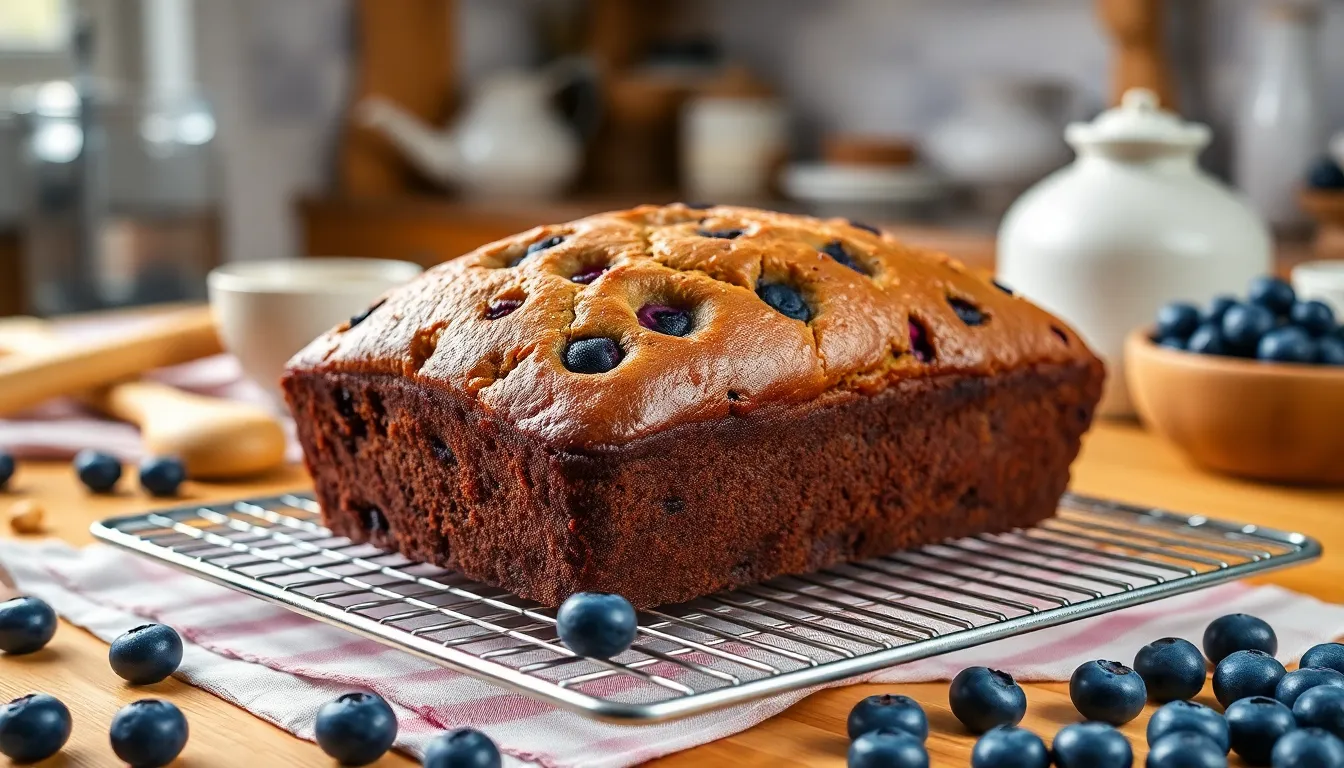
We love how blueberry bread transforms into the perfect make-ahead option for busy mornings and meal planning. This sweet quick bread stores beautifully and actually improves in flavor after resting, making it an ideal choice for weekend baking sessions.
Preparing for Storage
After our blueberry bread finishes baking and passes the toothpick test, we allow it to cool completely in the pan for 10 minutes before transferring to a wire rack. Complete cooling takes at least 2 hours and remains crucial for proper storage. Rushing this step creates condensation that leads to soggy bread and reduced shelf life.
Short-Term Storage Options
For immediate use within two days, we store the cooled bread at room temperature wrapped in plastic wrap or placed in an airtight container. Adding a paper towel to the container absorbs excess moisture and maintains the perfect texture. This method keeps our blueberry bread fresh and ready for quick breakfast or snack options.
Extended Storage Methods
When planning ahead for longer periods, we refrigerate wrapped blueberry bread for up to one week. The cool temperature preserves freshness while maintaining the moist crumb texture we worked hard to achieve.
Freezing for Maximum Storage
Our favorite make-ahead approach involves freezing blueberry bread for three to four months of extended storage. We wrap the completely cooled loaf tightly in plastic wrap, then add a layer of aluminum foil before placing it in a heavy-duty freezer bag. This triple-layer protection prevents freezer burn and locks in flavor.
Thawing and Serving
We thaw frozen blueberry bread overnight in the refrigerator for best results. Room temperature thawing takes several hours but works well when we need bread the same day. Both methods restore the original texture and taste, making our make-ahead bread indistinguishable from freshly baked.
Batch Baking Strategy
Making multiple loaves at once maximizes our time investment and provides ready-made options for weeks ahead. We often bake three loaves simultaneously, keeping one for immediate enjoyment and freezing the others for future use. This approach ensures we always have homemade blueberry bread available for unexpected guests or busy mornings.
Conclusion
We’ve shared everything you need to create the perfect blueberry bread that’ll become your go-to recipe. From proper mixing techniques to storage tips this comprehensive guide ensures your bread turns out moist and delicious every time.
Whether you’re making it for weekend breakfast or preparing gifts for friends this versatile recipe adapts to your needs. The variations we’ve covered let you customize flavors while our troubleshooting tips help you avoid common pitfalls.
Now it’s time to preheat your oven and start baking. With fresh blueberries and these proven techniques you’ll soon enjoy warm slices of homemade bread that rival any bakery. Your kitchen will smell amazing and your family will be asking for seconds.
Frequently Asked Questions
Can I use frozen blueberries instead of fresh ones?
Yes, you can use frozen blueberries in this recipe. Don’t thaw them before adding to the batter, as this prevents excess moisture and color bleeding. Coat frozen blueberries in flour just like fresh ones to ensure even distribution throughout the bread.
How do I prevent blueberries from sinking to the bottom?
Coat the blueberries in a light dusting of flour before folding them into the batter. This technique helps the berries stay suspended throughout the bread during baking, ensuring even distribution in every slice.
What’s the ideal baking temperature and time for blueberry bread?
Bake blueberry bread at 350°F (175°C) for 60-70 minutes in a 9×5-inch loaf pan. Use the toothpick test – insert a clean toothpick into the center, and it should come out clean or with just a few moist crumbs.
How do I know when my blueberry bread is done?
Check for doneness using multiple indicators: insert a toothpick into the center (should come out clean), look for a golden brown crust, ensure the center is set, and use a digital thermometer to confirm the internal temperature reaches 190-200°F (88-93°C).
How should I store blueberry bread?
Store at room temperature for up to 5 days wrapped in plastic or an airtight container. For longer storage, refrigerate for up to 7 days or freeze for 2-3 months. Always cool completely before storing to prevent condensation and sogginess.
Can I make mini blueberry loaves instead?
Yes, you can divide the batter among mini loaf pans for individual portions. Reduce the baking time to 25-35 minutes and check for doneness with a toothpick. Mini loaves are perfect for gifting or portion control.
Why is my blueberry bread dense or crumbly?
Dense bread usually results from overmixing the batter or incorrect measurements. Mix ingredients gently just until combined. Crumbly texture often indicates too much flour or insufficient liquid. Measure ingredients accurately and maintain proper flour-to-liquid ratios.
Can I make blueberry bread ahead of time?
Absolutely! Blueberry bread actually improves in flavor after resting. You can bake it 1-2 days ahead and store at room temperature, or freeze for up to 3 months. It’s perfect for meal prep and busy mornings.

